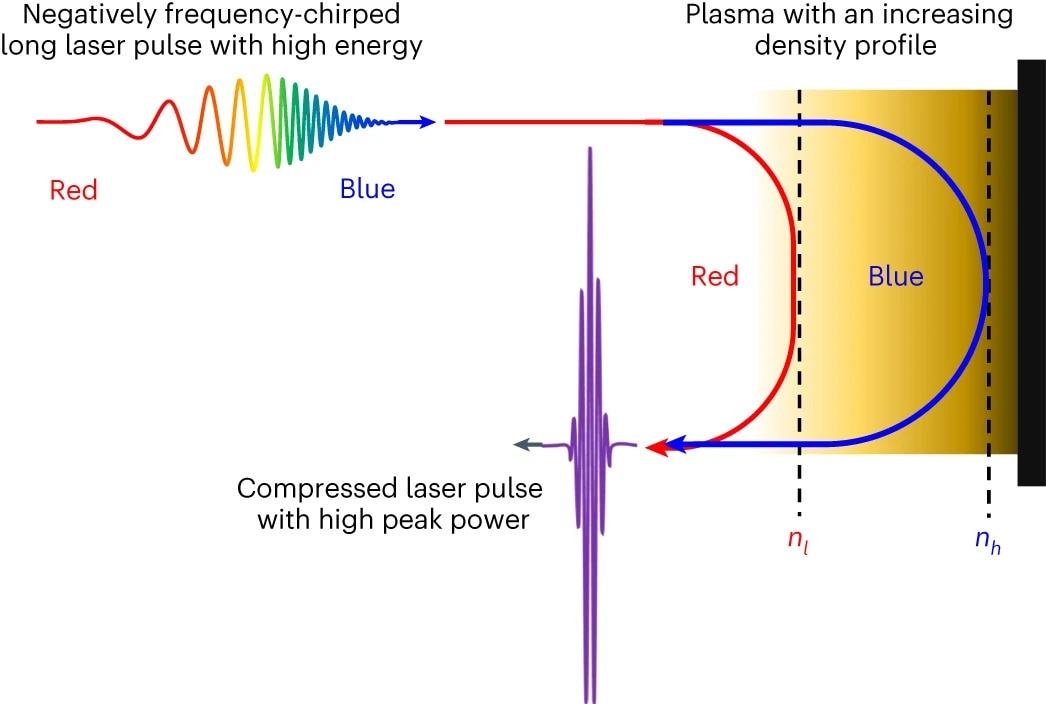
Pulse compression in plasma. The pulse’s high-frequency components (front) and low-frequency components (back) reflect at various positions, causing the laser pulse to compress. (Image Credit: Nature Photonics)
UK and South Korean scientists recently came up with a way to generate laser pulses 1,000 times more powerful than the ones used today. Computer simulations showed a new light compressing technique for sufficiently boosting its intensity to extract particles from a vacuum. They developed a mirror that reflects and compresses light pulses “in time by a factor of over two hundred times,” with additional compression possible.
Their concept involves using a plasma density’s gradient to force photons to “bunch,” similar to how a stretched-out group of cars bunch up when approaching a steep hill. Such a method like this could increase a laser’s power by over one million times versus what we’re seeing today.
The highest-power lasers have ten petawatts of peak power, and they generate light pulses for several femtoseconds, achieved via chirped pulse amplification (CPA). CPA relies on pulse compression that concentrates laser pulse energy in a short time. This increases the peak power by orders of magnitude.
“An important and fundamental question is what happens when light intensities exceed levels that are common on earth. High-power lasers allow scientists to answer basic questions on the nature of matter and the vacuum and explore what is known as the intensity frontier,” said Professor Dino Jaroszynski of the University of Strathclyde’s Department of Physics. “Applying terawatt to petawatt lasers to matter has enabled the development of next-generation laser-plasma accelerators, which are thousands of times smaller than conventional accelerators. Providing new tools for scientists is transforming the way science is done. We have set up the Scottish Centre for the Application of Plasma-based Accelerator (SCAPA) at the University of Strathclyde to push applications based on high-power lasers forward.”
Using a lens or curved mirror to focus the laser pulse to a small spot increases the intensity by a large amount. “In analogy with compressing a laser pulse in time to a short duration, the same thing can be done in space by compressing the pulse spatially, that is, focus it to a small spot.” Compression in time or space can boost the laser pulse intensity.
While the intensity increases, the matter usually goes through different changes. For instance, air is ionized above 1010 to 1012 W/cm2 intensities for visible light wavelengths. Also, exposing electrons to lasers that have intensities exceeding 1018 W/cm2 causes them to approach light speed, leading to the realm of relative optics. Protons approach light speeds at 1024 W/cm2 or higher, and “particles experiencing intense laser fields react to their own radiation fields, which is the current intensity frontier in physics.”
At 1029 W/cm2 or higher intensities, a vacuum can generate particles, allowing light to change into matter. That process relies on exawatt to zetawatt lasers. High-power lasers could also open the door to astrophysical phenomenon studies in the lab, offering glimpses into the interior of stars and the origin of the universe.
“The results of this research are expected to be applicable in various fields, including advanced theoretical physics and astrophysics. It can also be used in laser fusion research to help address the energy issues facing humanity. Our combined Korean and UK teams plan to experimentally test the ideas in the lab,” said Professor Min Sip Hur of UNIST.
Have a story tip? Message me at: http://twitter.com/Cabe_Atwell
